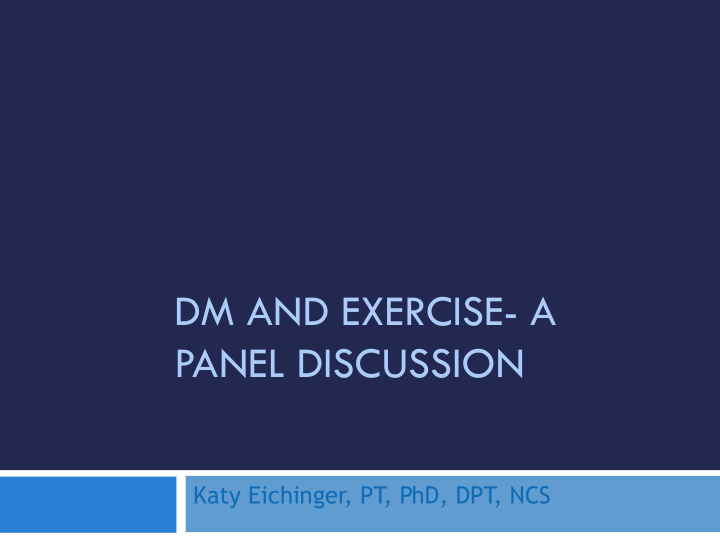



DM AND EXERCISE- A PANEL DISCUSSION Katy Eichinger, PT , PhD, DPT , NCS
Staying Strong ¨ Musculoskeletal involvement of DM results in progressive decline in strength ¨ Inactivity and aging also result in loss of muscle strength ¨ Physical activity and exercise are essential in minimizing strength loss secondary to disuse and inactivity.
Physical Activity Guidelines (2008) ¨ Aerobic training at a moderate intensity for 2 hours and 30 minutes (5 days of 30 minutes) ¨ Resistance exercise involving all major muscle groups on 2 or more days per week ¨ Moderate intensity: able to talk, but not able to sing ¨ Examples: brisk walking, water aerobics, bicycling, ballroom dancing, gardening
Physical Activity Guidelines for Adults with Disabilities (2008) ¨ Follow the adult guidelines. If this is not possible, these persons should be as physically active as their abilities allow. They should AVOID INACTIVITY.
Evidence for Exercise ¨ “Moderate intensity strength training appears not to do harm” (Cochrane Review, 2010) ¨ “There is level II evidence (likely to be effective) for strengthening exercises in combination with aerobic exercises for patients with muscle disorders.” (Cup et al., 2007) ¨ “Aerobic training is safe and can improve fitness effectively in patients with myotonic dystrophy.” (Orngreen et al., 2005)
Physical Activity and Exercise ¨ “Physical activity in daily life can be categorized into occupational, sports, conditioning, household, or other activities. Exercise is a subset of physical activity that is planned, structured, and repetitive and has as a final or an intermediate objective the improvement or maintenance of physical fitness.” (Caspersen, 1985)
Types of Exercise ¨ Stretching (range of motion) ¨ Strengthening (resistance training) ¨ Aerobic (cardiovascular training)
Known Benefits of Physical Activity/ Exercise ¨ Control your weight ¨ Reduce your risk of cardiovascular disease ¨ Reduce your risk for type 2 diabetes and metabolic syndrome ¨ Reduce your risk for some type of cancers ¨ Strengthen your bones and muscles ¨ Improve your mental health and mood ¨ Improve your ability to do daily activities and prevent falls, if you’re an older adult ¨ Increase your chances of living longer
Habitual Exercise and DM ¨ Retrospective study aimed to look at the differences in strength of individuals with DM1 who were habitually active or sedentary. ¨ Individuals with mid-range CTG repeats (100-500) who were engaged in regular exercise programs, demonstrated stronger grip, elbow flexor, and knee extensor strength than sedentary counterparts. ¨ Those who began an exercise program demonstrated a 24% gain in knee extensor strength. Brady et al., 2014
Minimize Sedentary Lifestyle ¨ Evidence is mounting regarding the detrimental effects of sitting/being sedentary ¨ Individuals with DM were noted to sit 7.5 hours/ day! ¨ Be as physically active as you are able ¨ Set a timer to get up and move around
Overcoming Barriers to Physical Activity Motivation ü Plan ahead. Make physical activity a regular part of your daily or weekly schedule and write it on your calendar. ü Invite a friend to exercise with you on a regular basis and write it on both your calendars. ü Join an exercise group or class ü Schedule physical activity for times in the Fatigue/Lack of Energy day or week when you feel energetic. ü Convince yourself that if you give it a chance, physical activity will increase your energy level; then, try it Promoting Physical Activity: A Guide for Community Action (USDHHS, 1999)
Exercise
Exercise
Physical Activity
Physical Therapy
My Story The Guy You Love to Hate
Exercise: ¨ ABILITY ¨ DESIRE ¨ BENEFIT
LET’S GET STARTED!
Tools of the Trade:
Motivation
Recommend
More recommend